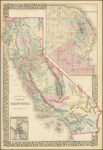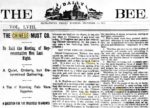In 1871 California had fifty different counties. These counties were outlined in water color on an 1871 County Map of the State of California. Counties yet to be created were Glenn, Imperial, Kings, Madera, Modoc, Orange, Riverside, San Benito, and Ventura. The 1871 map also has an inset of San Francisco that also has water-colored […]










